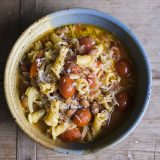In Sicily, the cliché seems to stand—the Mafia is everywhere. Or rather, was. Even here at Cantina della Val di Suro, a sunbaked and sprawling winery perched on a hill nestled in a valley wedged between the Tyrrhenian Sea and the Madonie Mountains.
Accessed only via up-down-side-to-side-over-and-again gut-wrenching roads, the business until recently was owned by the Mafia, the vintages named for the family’s children. Because of course. Yet neither the drive nor the lineage seems to bother the winery’s cook, Piera Ferruzza, who’d agreed to teach me rustic Sicilian cooking.
At the moment, she’s more focused on her beans—plump, brown borlotti that have simmered for an hour with chopped yellow onions and rosemary, the first and richly aromatic stage of pasta con fagioli, which she is preparing for me and Salvatore Messineo, the retired stolen art investigator to whom the Italian government entrusted the winery when it was taken from the Mafia. Because of course.
The winery’s history is complex; Ferruzza’s cooking is not. In a white plaster-and-terra cotta kitchen with soaring ceilings and views of rolling hills that stretch down to the sea, she prepares sausages so tender they bleed juices onto the roasted potatoes they accompany. Ditalini pasta is tossed creamy with ricotta and olive oil.
And the pasta con fagioli—pasta with beans—a recipe that, if we are being honest, sounds better suited to college-dorm cooking. Yet in Ferruzza’s hands, it is substantial, rustic, clean and herbal. No. It is wonderful. Her method is simple: Those beans, thickly saucy and richly infused with rosemary and garlic, are tossed with more ditalini and a splash of the starchy cooking water. Grated ricotta salata cheese adds creamy-salty notes that balance the meaty yet tender beans. A whole greater than the sum.
Such a simple marriage of ingredients, yet so satisfying. But I wondered whether it was the wine talking—for it flowed liberally that lunch. Until later that day, when I made my way an hour inland to Castelbuono, a 14th-century hilltop town and home to Maria Enza Arena, a shopkeeper who’d agreed to teach me the same dish, cooking on her outdoor patio kitchen overlooking a similarly evocative and equally rolling Sicilian countryside.
Of course, same is relative. In Sicily—as with much of Italy—“same” changes region to region, town to town, parent to child. Arena favors red over yellow onions, adds diced carrots and grape tomatoes; the former to sweeten the dish, the latter to add gentle acidity. She also adds wild fennel fronds that grow weed-like in her yard, adding a lightly peppery note. And she leaves off the cheese, allowing the starch of the pasta and beans to give the dish all the creamy body it needs.
Back at Milk Street, we created a streamlined hybrid of the two dishes. We liked Arena’s addition of tomatoes, which helped lighten and brighten the heavier ingredients. But much as we loved her use of wild fennel—her husband tried to send me home with armfuls of it—it’s not common here. Instead, we got the same anise flavor by combining fennel bulb and fennel seeds.
Though we liked the dish topped with ricotta salata, we liked it even better with the more assertively flavored pecorino Romano, a cousin cheese (ricotta salata is often made from the whey left in the making of pecorino Romano). The result was delicious, but still felt a bit flat. Our out-of-season tomatoes weren’t adding the same sweetness or acidity as Arena’s Sicilian varieties. So to brighten the dish a bit, we added lemon zest and juice.
The result was robust, yet light and herbal. A pasta even a Mafia Don could love.




